
















How to Build a
Portable Solar Power Generator
and
The Basics of Solar Power
Copyright © December 1, 2005 by Robert Wayne Atkins, P.E.
All Rights Reserved.
On a camping trip it is nice to have some of the luxuries we enjoy at home. For example, your children may still want to play their hand-held electronic games, such as a Game Boy. Or you may occasionally want to use your laptop computer, either to play a game, or to watch a DVD movie. If you have a cell phone, then you may need to recharge its battery. Therefore, a portable solar generator would be a nice item to have on a camping trip. However, for this to be a viable option, you would need to drive to your campsite in your car or truck, because the size and weight of a solar generator exceeds what you can carry in a backpack.
Although a regular generator will produce more power than a solar generator, a regular generator requires a continuous source of fuel, which may not be readily available at your campsite. And the noise of a regular generator may not be appropriate at most public campgrounds. On the other hand, a solar generator is able to produce small amounts of power whenever the sun is shining and it is virtually silent. Therefore, a solar generator is a more practical item on a camping trip than a conventional gas-operated generator.
Before we look at how to build a simple homemade solar generator, we need to review the basic principles of solar power.
The Basics of Solar Power
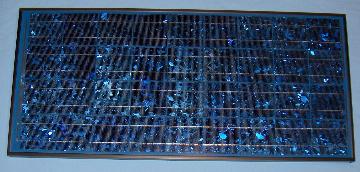 Solar Panels: A solar panel converts the sunís energy into Direct Current, or DC electricity. Solar panels come in a variety of different sizes and shapes. For the purpose of this discussion we will classify them as either small or large. The solar panel in the picture on the right is a large panel which is rated at 64-watts per hour and its dimensions are approximately 18" wide, 44" long, and 1.5" thick. It weighs approximately 22 pounds.
Solar Panels: A solar panel converts the sunís energy into Direct Current, or DC electricity. Solar panels come in a variety of different sizes and shapes. For the purpose of this discussion we will classify them as either small or large. The solar panel in the picture on the right is a large panel which is rated at 64-watts per hour and its dimensions are approximately 18" wide, 44" long, and 1.5" thick. It weighs approximately 22 pounds.
Small solar panels produce very low DC voltages, such as 1.5 volts for flashlight batteries. Small solar panels are not appropriate for a portable solar generator. (Note: If you are only interested in recharging flashlight size batteries, then please click here.)
Large solar panels produce 12-volts DC, which is the same as automobile or boat batteries. Larger solar panels are designed and rated for a certain number of peak watts, such as 60W, or 75W, or 100W. If you had a 100-watt solar panel, you could keep a 100-watt light bulb burning for the length of time the sun was shining directly on the solar panel at a 90 degree angle. Since you probably wouldn't want to use the light bulb during the day, you would need a method to store that energy for future use. (Note: In my opinion, it might be better to purchase two smaller 60-watt panels instead of one large 100-watt panel. If one of the 60-watt panels were to become damaged then it could be disconnected, and the other panel could still provide some power.)
At the current time monocrystalline solar panels are the best type of solar panel.
Batteries: There are many different types and sizes of batteries. They can be used to store the power from a solar panel so that power can be used at some future time. If you are considering the purchase of a 12-volt solar panel, then you should consider the purchase of 12-volt deep-cycle marine or golf cart batteries, so you can store the power from your solar panel(s). Deep-cycle marine and golf cart batteries are of the same appoximate size, appearance, and weight as the 12-volt battery in your car. However, the battery in your car is designed for short periods of high energy output. A deep-cycle battery is designed for long periods of continuous power output. The battery will be the heaviest component in your solar system.
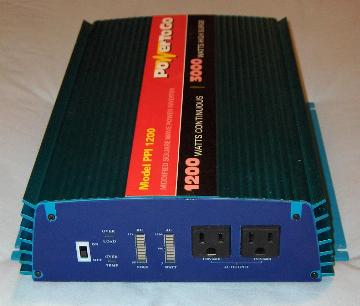 Inverters: An inverter changes the DC power from a battery into Alternating Current, or AC electricity, which is what we use in our homes. Although the inverter may be attached to a 12-volt battery, it will produce 110-volt electricity which is powerful enough to kill you. Therefore, you must use the same degree of caution with an inverter that you would for any household appliance. Most inverters have standard three prong electrical outlets for standard household appliances to plug into. Inverters are rated for the number of continuous watts they can produce, such as 100-watts, or 1000-watts. They also specify peak watts, but the peak watts is for a very short moment of time, and therefore you should rely on the rating for continuous watt output. When choosing an inverter, you should first determine what equipment you need to operate. Then purchase an inverter that will produce that number of watts. For example, if you want to operate a 700-watt microwave for 90 seconds, then you would need at least an 800-watt inverter, to provide a small safety margin. The inverter in the picture on the right is a 1200-watt inverter and its dimensions are approximately 10" wide, 13" long, and 3" high. It weighs approximately 10 pounds. The components on the front panel from left to right are: on/off switch, volt meter, watt meter, and two 110-volt outlets.
Inverters: An inverter changes the DC power from a battery into Alternating Current, or AC electricity, which is what we use in our homes. Although the inverter may be attached to a 12-volt battery, it will produce 110-volt electricity which is powerful enough to kill you. Therefore, you must use the same degree of caution with an inverter that you would for any household appliance. Most inverters have standard three prong electrical outlets for standard household appliances to plug into. Inverters are rated for the number of continuous watts they can produce, such as 100-watts, or 1000-watts. They also specify peak watts, but the peak watts is for a very short moment of time, and therefore you should rely on the rating for continuous watt output. When choosing an inverter, you should first determine what equipment you need to operate. Then purchase an inverter that will produce that number of watts. For example, if you want to operate a 700-watt microwave for 90 seconds, then you would need at least an 800-watt inverter, to provide a small safety margin. The inverter in the picture on the right is a 1200-watt inverter and its dimensions are approximately 10" wide, 13" long, and 3" high. It weighs approximately 10 pounds. The components on the front panel from left to right are: on/off switch, volt meter, watt meter, and two 110-volt outlets.
Most inexpensive inverters produce low quality AC electricity. For example, if you plug a TV set into an inverter, you will normally see wavy lines on the TV screen, which are the result of the low quality power. On a TV set it is possible to reduce the wavy line effect by plugging a 25-foot extension cord into the inverter. Then coil the extension cord into a small stack of circles (about 12-inch diameters), one on top of the other, on the floor. Then plug the TV into the opposite end of the extension cord. You should see a noticeable reduction in the wavy line effect on the TV screen.
Before you invest a lot of money in a solar system, you should research the costs and benefits very carefully. There are a variety of other components that need to be included in a larger self-maintaining solar system. The power question does not have an easy answer. There are so many variables that there is no one right answer that would be suitable for the needs of all families. Most companies that sell solar equipment have trained professionals that can answer all your questions and help you select exactly what you need for the application you have in mind.
How to Build a Homemade Portable Solar Generator
Now let's look at how to assemble the above components into a simple portable solar generator that could be used on a camping trip.
A portable solar generator consists of the following items:
One (or more) 12-volt solar panels,
One (or more) 12-volt deep-cycle batteries (such as marine or golf cart batteries),
One (or more) 12-volt cigarette lighter adapters,
One inverter.
In the wiring diagram illustration below I have shown one solar panel and one deep-cycle battery in order to illustrate how to build a basic solar generator.

When considering the purchase of an inverter, I would recommend either a 1,000 or 1,200-watt inverter (continuous power output). If you wish to purchase a larger inverter then I suggest no more than 2,000-watts. This recommendation applies to a portable solar generator that will be used to supply power to a wide variety of potential applications. If you purchase an inverter that is less than 1,000-watts then you will be limiting the number of potential applications for your solar generator. Also, the larger inverters are usually of higher quality and they have a few more features, such as a meter that shows how much power is remaining in your 12-volt batteries, and how much power you are using at the present time. These are really nice meters to have built into your inverter. If your inverter does NOT have these built-in meters, then you will need to purchase a separate DC voltmeter to monitor the charge in your 12-volt batteries.
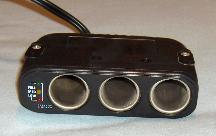 In addition to the inverter, you should also install a 12-volt cigarette lighter adapter on your solar generator system. This will allow you to recharge any battery-operated item that has a cigarette lighter adapter, such as a cell phone, or a Game Boy, or a laptop computer. You can purchase these adapters at most electronic stores, including Radio Shack. Radio Shack normally has a one-hole adapter and a three-hole adapter. I recommend the three-hole adapter if you will only be recharging simple items like a cell phone or a Game Boy. The adapter on the right weighs approximately 7 ounces and it measures 3" wide by 4" long by 1" high. If you are going to be recharging batteries that require a higher level of power then you should consider purchasing several single-hole adapters to minimize overheating of the adapter wiring.
In addition to the inverter, you should also install a 12-volt cigarette lighter adapter on your solar generator system. This will allow you to recharge any battery-operated item that has a cigarette lighter adapter, such as a cell phone, or a Game Boy, or a laptop computer. You can purchase these adapters at most electronic stores, including Radio Shack. Radio Shack normally has a one-hole adapter and a three-hole adapter. I recommend the three-hole adapter if you will only be recharging simple items like a cell phone or a Game Boy. The adapter on the right weighs approximately 7 ounces and it measures 3" wide by 4" long by 1" high. If you are going to be recharging batteries that require a higher level of power then you should consider purchasing several single-hole adapters to minimize overheating of the adapter wiring.
The simple solar generator illustrated in the above wiring diagram can be used to recharge your laptop computer battery, the battery in your child's Game Boy, and any rechargeable flashlight batteries you might have (if you also have a 110-volt battery recharger for your rechargeable batteries). The solar generator should NOT be used to operate heating (or cooling) appliances because they will drain the power from your batteries very quickly. In other words, no hair dryers or electric heaters or air-conditioners. However, you can operate small fans (either a 12-volt fan plugged into the cigarette lighter adapter, or a 110-volt fan plugged into the inverter.)
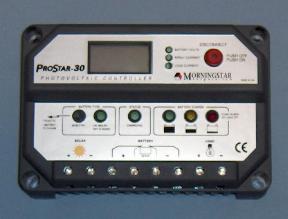 The optional solar charge controller is recommended to prevent damage to the 12-volt battery, primarily through overcharging. The solar charge controller in the picture on the right has dimensions of approximately 4.5" wide, 6" long, and 2" high. It weighs approximately 13 ounces. At the current time an MPPT solar charge controller is the best type of solar charge controller. If you purchase a solar charge controller then be sure it can handle the wattage and amperage of all your solar panels.
The optional solar charge controller is recommended to prevent damage to the 12-volt battery, primarily through overcharging. The solar charge controller in the picture on the right has dimensions of approximately 4.5" wide, 6" long, and 2" high. It weighs approximately 13 ounces. At the current time an MPPT solar charge controller is the best type of solar charge controller. If you purchase a solar charge controller then be sure it can handle the wattage and amperage of all your solar panels.
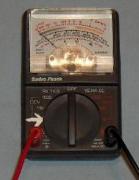 If you do not have a solar controller, then you should disconnect the battery from the solar panel at night. You should also disconnect the battery if you are not going to be present to periodically monitor the charge going into the battery. And you should cover the solar panel with a blanket to prevent it from producing power.
If you do not have a solar controller, then you should disconnect the battery from the solar panel at night. You should also disconnect the battery if you are not going to be present to periodically monitor the charge going into the battery. And you should cover the solar panel with a blanket to prevent it from producing power.
If you decide to omit the optional solar controller then you will need to purchase a DC voltmeter and periodically check the charge in your 12-volt battery to verify that you are not overcharging the battery during daylight hours. The DC voltmeter in the picture on the left has dimensions of approximately 2.5" wide, 4" long, and 1" high. (Note: You will not need this additional DC voltmeter if you have a solar controller, or if you have an inverter with a built-in voltmeter.)
The wiring-diagram illustration of a portable solar generator can be modified based on your individual requirements. You can add additional solar panels and/or additional 12-volt batteries to your system if you wish. The wiring diagram illustration below shows three solar panels and three 12-volt batteries. If you wish to use two panels or batteries, just remove the one in the center. If you wish to use four or more panels or batteries, just add them to the center.
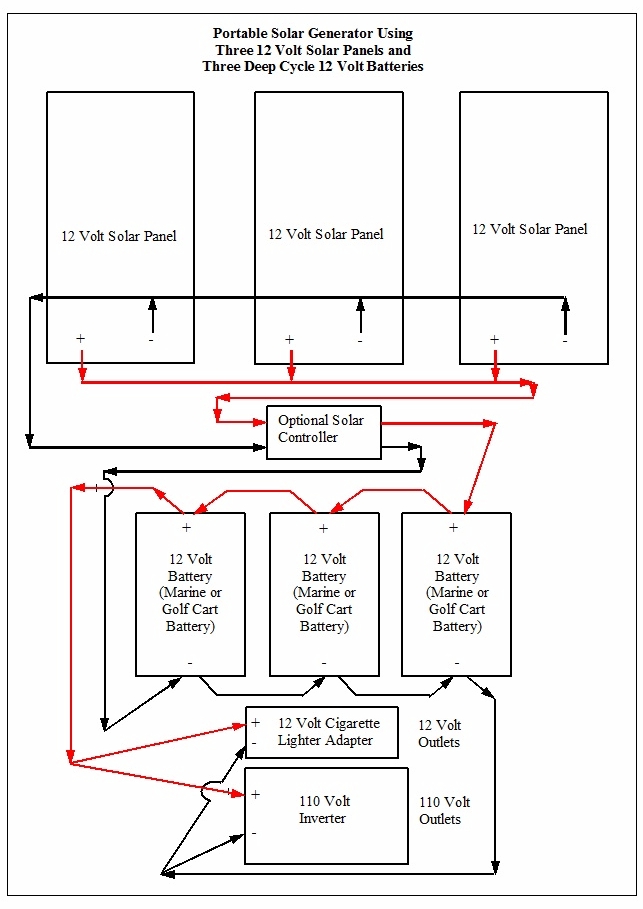
You do not need to have exactly the same number of solar panels as 12-volt deep cycle batteries.
Since it does rain occasionally, it is usually better to have more 12-volt batteries than solar panels. This gives you the ability to store power for use during bad weather.
If you decide to build your own solar generator, then you should utilize the talents of the solar professionals at the company where you purchase your solar panels. You can ask them specific questions about the size of the solar panels in relation to the number of 12-volt deep-cycle batteries you will require. They will also be able to recommend the appropriate solar controller for the type of system you decide to build.
Normally one of the major cost of the 12-volt deep-cycle batteries is the shipping cost. Therefore it is usually wise to find a battery dealer near your home to purchase your batteries. This not only minimizes your cost, but it also simplifies warranty and return issues if your deep-cycle battery does not perform as expected. One source of those batteries is your local WalMart or Sam's Club.
Respectfully,
Grandpappy.
Grandpappy's e-mail address is: RobertWayneAtkins@hotmail.com




































 Solar Panels: A solar panel converts the sunís energy into Direct Current, or DC electricity. Solar panels come in a variety of different sizes and shapes. For the purpose of this discussion we will classify them as either small or large. The solar panel in the picture on the right is a large panel which is rated at 64-watts per hour and its dimensions are approximately 18" wide, 44" long, and 1.5" thick. It weighs approximately 22 pounds.
Solar Panels: A solar panel converts the sunís energy into Direct Current, or DC electricity. Solar panels come in a variety of different sizes and shapes. For the purpose of this discussion we will classify them as either small or large. The solar panel in the picture on the right is a large panel which is rated at 64-watts per hour and its dimensions are approximately 18" wide, 44" long, and 1.5" thick. It weighs approximately 22 pounds. Inverters: An inverter changes the DC power from a battery into Alternating Current, or AC electricity, which is what we use in our homes. Although the inverter may be attached to a 12-volt battery, it will produce 110-volt electricity which is powerful enough to kill you. Therefore, you must use the same degree of caution with an inverter that you would for any household appliance. Most inverters have standard three prong electrical outlets for standard household appliances to plug into. Inverters are rated for the number of continuous watts they can produce, such as 100-watts, or 1000-watts. They also specify peak watts, but the peak watts is for a very short moment of time, and therefore you should rely on the rating for continuous watt output. When choosing an inverter, you should first determine what equipment you need to operate. Then purchase an inverter that will produce that number of watts. For example, if you want to operate a 700-watt microwave for 90 seconds, then you would need at least an 800-watt inverter, to provide a small safety margin. The inverter in the picture on the right is a 1200-watt inverter and its dimensions are approximately 10" wide, 13" long, and 3" high. It weighs approximately 10 pounds. The components on the front panel from left to right are: on/off switch, volt meter, watt meter, and two 110-volt outlets.
Inverters: An inverter changes the DC power from a battery into Alternating Current, or AC electricity, which is what we use in our homes. Although the inverter may be attached to a 12-volt battery, it will produce 110-volt electricity which is powerful enough to kill you. Therefore, you must use the same degree of caution with an inverter that you would for any household appliance. Most inverters have standard three prong electrical outlets for standard household appliances to plug into. Inverters are rated for the number of continuous watts they can produce, such as 100-watts, or 1000-watts. They also specify peak watts, but the peak watts is for a very short moment of time, and therefore you should rely on the rating for continuous watt output. When choosing an inverter, you should first determine what equipment you need to operate. Then purchase an inverter that will produce that number of watts. For example, if you want to operate a 700-watt microwave for 90 seconds, then you would need at least an 800-watt inverter, to provide a small safety margin. The inverter in the picture on the right is a 1200-watt inverter and its dimensions are approximately 10" wide, 13" long, and 3" high. It weighs approximately 10 pounds. The components on the front panel from left to right are: on/off switch, volt meter, watt meter, and two 110-volt outlets.
 In addition to the inverter, you should also install a 12-volt cigarette lighter adapter on your solar generator system. This will allow you to recharge any battery-operated item that has a cigarette lighter adapter, such as a cell phone, or a Game Boy, or a laptop computer. You can purchase these adapters at most electronic stores, including Radio Shack. Radio Shack normally has a one-hole adapter and a three-hole adapter. I recommend the three-hole adapter if you will only be recharging simple items like a cell phone or a Game Boy. The adapter on the right weighs approximately 7 ounces and it measures 3" wide by 4" long by 1" high. If you are going to be recharging batteries that require a higher level of power then you should consider purchasing several single-hole adapters to minimize overheating of the adapter wiring.
In addition to the inverter, you should also install a 12-volt cigarette lighter adapter on your solar generator system. This will allow you to recharge any battery-operated item that has a cigarette lighter adapter, such as a cell phone, or a Game Boy, or a laptop computer. You can purchase these adapters at most electronic stores, including Radio Shack. Radio Shack normally has a one-hole adapter and a three-hole adapter. I recommend the three-hole adapter if you will only be recharging simple items like a cell phone or a Game Boy. The adapter on the right weighs approximately 7 ounces and it measures 3" wide by 4" long by 1" high. If you are going to be recharging batteries that require a higher level of power then you should consider purchasing several single-hole adapters to minimize overheating of the adapter wiring. The optional solar charge controller is recommended to prevent damage to the 12-volt battery, primarily through overcharging. The solar charge controller in the picture on the right has dimensions of approximately 4.5" wide, 6" long, and 2" high. It weighs approximately 13 ounces. At the current time an MPPT solar charge controller is the best type of solar charge controller. If you purchase a solar charge controller then be sure it can handle the wattage and amperage of all your solar panels.
The optional solar charge controller is recommended to prevent damage to the 12-volt battery, primarily through overcharging. The solar charge controller in the picture on the right has dimensions of approximately 4.5" wide, 6" long, and 2" high. It weighs approximately 13 ounces. At the current time an MPPT solar charge controller is the best type of solar charge controller. If you purchase a solar charge controller then be sure it can handle the wattage and amperage of all your solar panels. If you do not have a solar controller, then you should disconnect the battery from the solar panel at night. You should also disconnect the battery if you are not going to be present to periodically monitor the charge going into the battery. And you should cover the solar panel with a blanket to prevent it from producing power.
If you do not have a solar controller, then you should disconnect the battery from the solar panel at night. You should also disconnect the battery if you are not going to be present to periodically monitor the charge going into the battery. And you should cover the solar panel with a blanket to prevent it from producing power.

